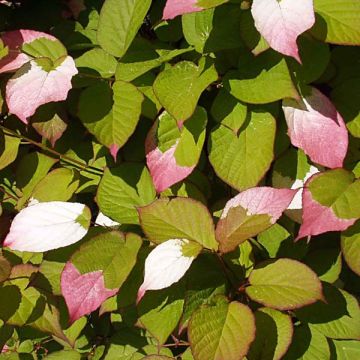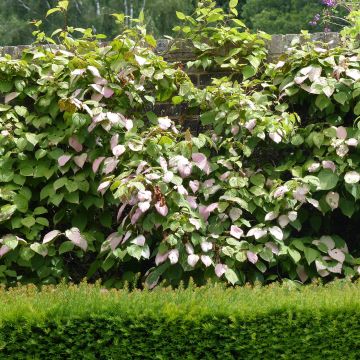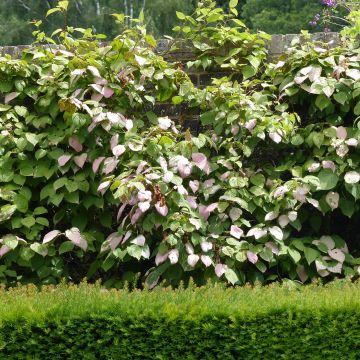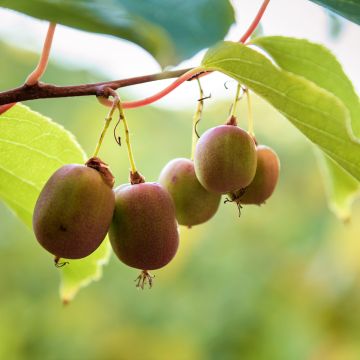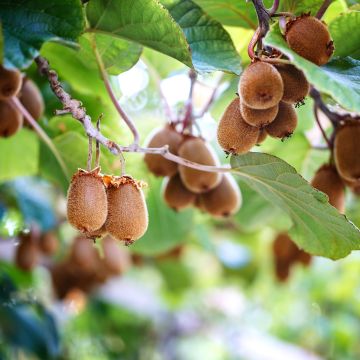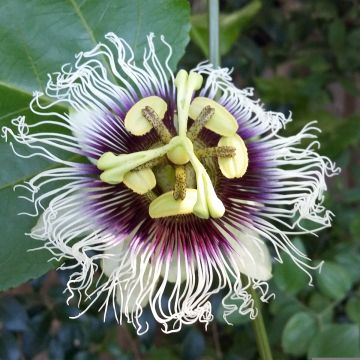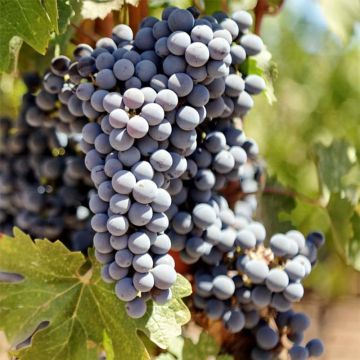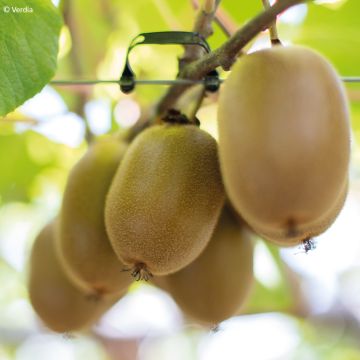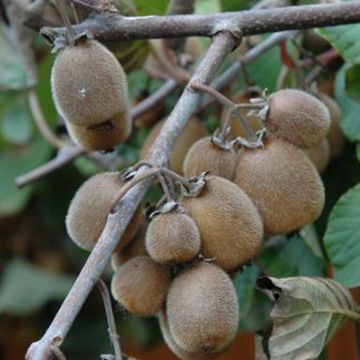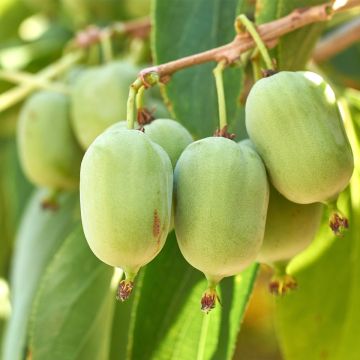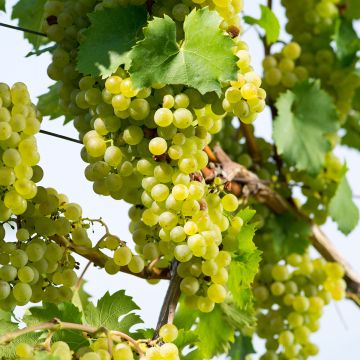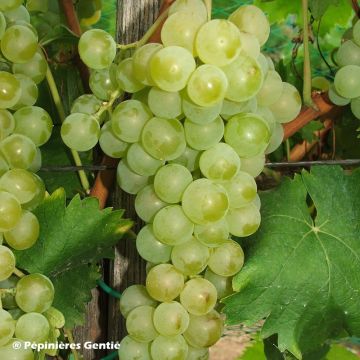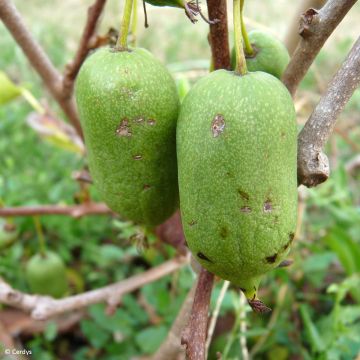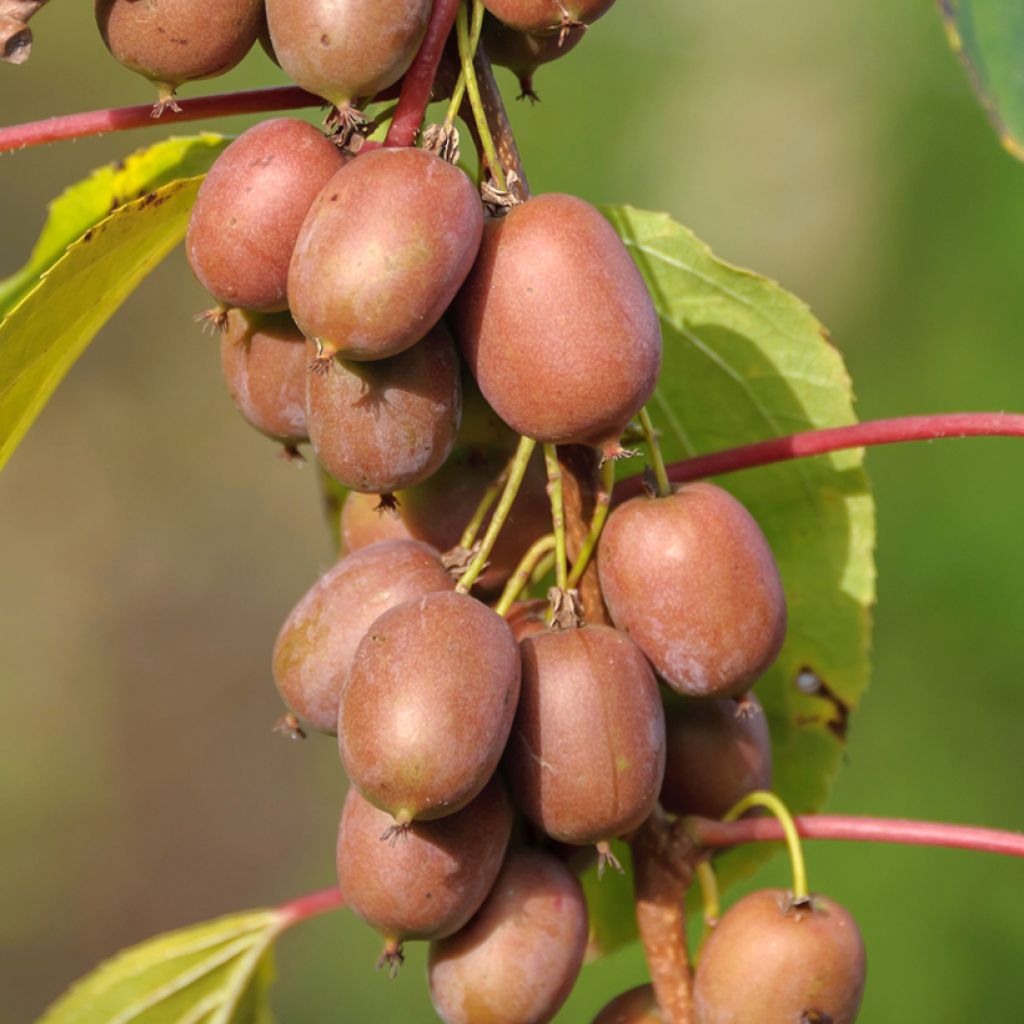

Actinidia kolomikta Red Beauty
Actinidia kolomikta Red Beauty
Actinidia kolomikta Red Beauty
Kolomikta, Michurin Actinidia
This item cannot be shipped to the selected country
Delivery charge from €5.90
More information
Schedule delivery date,
and select date in basket
This plant carries a 6 months recovery warranty
More information
We guarantee the quality of our plants for a full growing cycle, and will replace at our expense any plant that fails to recover under normal climatic and planting conditions.
From €5.90 for pickup delivery and €6.90 for home delivery
Express home delivery from €8.90.
Description
The Actinidia kolomikta 'Red Beauty', a female variety of Arctic Kiwi, is a fruit climbing plant that will also charm with its ornamental qualities. Its leaves turn red at the end of the season, its delicate scented spring flowers, and its small sweet red kiwis make this plant an interesting subject from spring to autumn. To successfully grow it, provide a support for its voluble stems to climb on. It is essential to plant a male variety to obtain fruits, especially 'Actic Beauty' or, at a stretch, 'Adam' in not too cold climates.
The 'Red Beauty' kiwi is a horticultural selection of Actinidia kolomikta. This plant belongs to the Actinidiaceae family. The wild species is native to an area ranging from China to Japan, Korea, and Russia, where it can be found in the Amur River region and on Sakhalin Island, for example. Its natural habitat consists of not too dense coniferous forests, where the plant can form thickets along the banks or in clearings. In the southern part of its range, this Actinidia grows up to 1300-1400m above sea level, on rocky plateaus. In the north, however, this species does not climb above 150m above sea level. This kiwi was introduced into cultivation in 1855.
The Actinidia kolomikta 'Red Beauty' is a fast-growing woody plant, with voluble stems that grow 60cm per year and quickly reach 5 to 6m in length. They will need to be guided onto a support for them to climb on. This female cultivar is characterised by its spreading habit, naturally hugging the ground if its growth is not guided. Its large oval leaves, dark green and sometimes tinged with reddish, turn dark red in autumn before falling. The cream-white flowers with yellow anthers, pleasantly scented, resembling small buttercups, appear between May and June. The small oval fruits (3cm long and 1.5cm wide), but produced abundantly, ripen from September to late October. These small kiwis are sweet and delicious when eaten fresh, as they are or in a fruit salad. Their skin is thin and they can be eaten like grapes.
Like most kiwis, Actinidia kolomikta is dioecious: there are male plants separate from female plants like 'Red Beauty'. Only the latter will bear fruits, and only in the presence of a male plant nearby.
The 'Red Beauty' Arctic Kiwi is interesting for creating fruit hedges due to its dense foliage and vigorous growth. It can also be used in an orchard to enjoy its tasty fruits. Planted at the base of a fence, a large trellis, or another rigid structure, this climbing plant grows upwards, creating natural and decorative screens. To accompany Actinidia kolomikta 'Red Beauty', plant a pollinator male plant, add the Actinidia arguta 'Issai', which also produces edible fruits, a Clematis montana like 'Rubens', known for its spectacular spring flowering, a Hydrangea petiolaris, another climbing vine with beautiful white flowers, and the Parthenocissus quinquefolia, a vigorous climber with decorative autumn foliage. These plants, all tolerant of partial shade, will create a harmonious and varied setting throughout the seasons.
Report an error about the product description
Plant habit
Fruit
Flowering
Foliage
Botanical data
Actinidia
kolomikta
Red Beauty
Actinidiaceae
Kolomikta, Michurin Actinidia
Cultivar or hybrid
Other Ornamental Kiwi - Actinidia
Planting and care
The Actinidia kolomikta 'Red Beauty' is sensitive to severe frosts, but can withstand brief freezes of around -14°C: prefer a sheltered location with a rich and well-drained soil, neutral or acidic (it does not appreciate limestone soils). A soil rich in humus, which is light, fertile and moist, is ideal. Mulch the plant in autumn to protect the stump from the cold. In case of harsh winter, prune it severely in spring. This plant is quite greedy and appreciates organic fertilisers in spring. It does not require pruning. However, you can shorten the year's stems by about a third in autumn. To promote fruiting, prefer a sunny location, but not overly hot. The vegetation of this actinidia can be quite heavy and may require staking after one or two years.
Planting period
Intended location
Care
This item has not been reviewed yet - be the first to leave a review about it.
Fruit-bearing climbers
Haven't found what you were looking for?
Hardiness is the lowest winter temperature a plant can endure without suffering serious damage or even dying. However, hardiness is affected by location (a sheltered area, such as a patio), protection (winter cover) and soil type (hardiness is improved by well-drained soil).

Photo Sharing Terms & Conditions
In order to encourage gardeners to interact and share their experiences, Promesse de fleurs offers various media enabling content to be uploaded onto its Site - in particular via the ‘Photo sharing’ module.
The User agrees to refrain from:
- Posting any content that is illegal, prejudicial, insulting, racist, inciteful to hatred, revisionist, contrary to public decency, that infringes on privacy or on the privacy rights of third parties, in particular the publicity rights of persons and goods, intellectual property rights, or the right to privacy.
- Submitting content on behalf of a third party;
- Impersonate the identity of a third party and/or publish any personal information about a third party;
In general, the User undertakes to refrain from any unethical behaviour.
All Content (in particular text, comments, files, images, photos, videos, creative works, etc.), which may be subject to property or intellectual property rights, image or other private rights, shall remain the property of the User, subject to the limited rights granted by the terms of the licence granted by Promesse de fleurs as stated below. Users are at liberty to publish or not to publish such Content on the Site, notably via the ‘Photo Sharing’ facility, and accept that this Content shall be made public and freely accessible, notably on the Internet.
Users further acknowledge, undertake to have ,and guarantee that they hold all necessary rights and permissions to publish such material on the Site, in particular with regard to the legislation in force pertaining to any privacy, property, intellectual property, image, or contractual rights, or rights of any other nature. By publishing such Content on the Site, Users acknowledge accepting full liability as publishers of the Content within the meaning of the law, and grant Promesse de fleurs, free of charge, an inclusive, worldwide licence for the said Content for the entire duration of its publication, including all reproduction, representation, up/downloading, displaying, performing, transmission, and storage rights.
Users also grant permission for their name to be linked to the Content and accept that this link may not always be made available.
By engaging in posting material, Users consent to their Content becoming automatically accessible on the Internet, in particular on other sites and/or blogs and/or web pages of the Promesse de fleurs site, including in particular social pages and the Promesse de fleurs catalogue.
Users may secure the removal of entrusted content free of charge by issuing a simple request via our contact form.
The flowering period indicated on our website applies to countries and regions located in USDA zone 8 (France, the United Kingdom, Ireland, the Netherlands, etc.)
It will vary according to where you live:
- In zones 9 to 10 (Italy, Spain, Greece, etc.), flowering will occur about 2 to 4 weeks earlier.
- In zones 6 to 7 (Germany, Poland, Slovenia, and lower mountainous regions), flowering will be delayed by 2 to 3 weeks.
- In zone 5 (Central Europe, Scandinavia), blooming will be delayed by 3 to 5 weeks.
In temperate climates, pruning of spring-flowering shrubs (forsythia, spireas, etc.) should be done just after flowering.
Pruning of summer-flowering shrubs (Indian Lilac, Perovskia, etc.) can be done in winter or spring.
In cold regions as well as with frost-sensitive plants, avoid pruning too early when severe frosts may still occur.
The planting period indicated on our website applies to countries and regions located in USDA zone 8 (France, United Kingdom, Ireland, Netherlands).
It will vary according to where you live:
- In Mediterranean zones (Marseille, Madrid, Milan, etc.), autumn and winter are the best planting periods.
- In continental zones (Strasbourg, Munich, Vienna, etc.), delay planting by 2 to 3 weeks in spring and bring it forward by 2 to 4 weeks in autumn.
- In mountainous regions (the Alps, Pyrenees, Carpathians, etc.), it is best to plant in late spring (May-June) or late summer (August-September).
The harvesting period indicated on our website applies to countries and regions in USDA zone 8 (France, England, Ireland, the Netherlands).
In colder areas (Scandinavia, Poland, Austria...) fruit and vegetable harvests are likely to be delayed by 3-4 weeks.
In warmer areas (Italy, Spain, Greece, etc.), harvesting will probably take place earlier, depending on weather conditions.
The sowing periods indicated on our website apply to countries and regions within USDA Zone 8 (France, UK, Ireland, Netherlands).
In colder areas (Scandinavia, Poland, Austria...), delay any outdoor sowing by 3-4 weeks, or sow under glass.
In warmer climes (Italy, Spain, Greece, etc.), bring outdoor sowing forward by a few weeks.

































